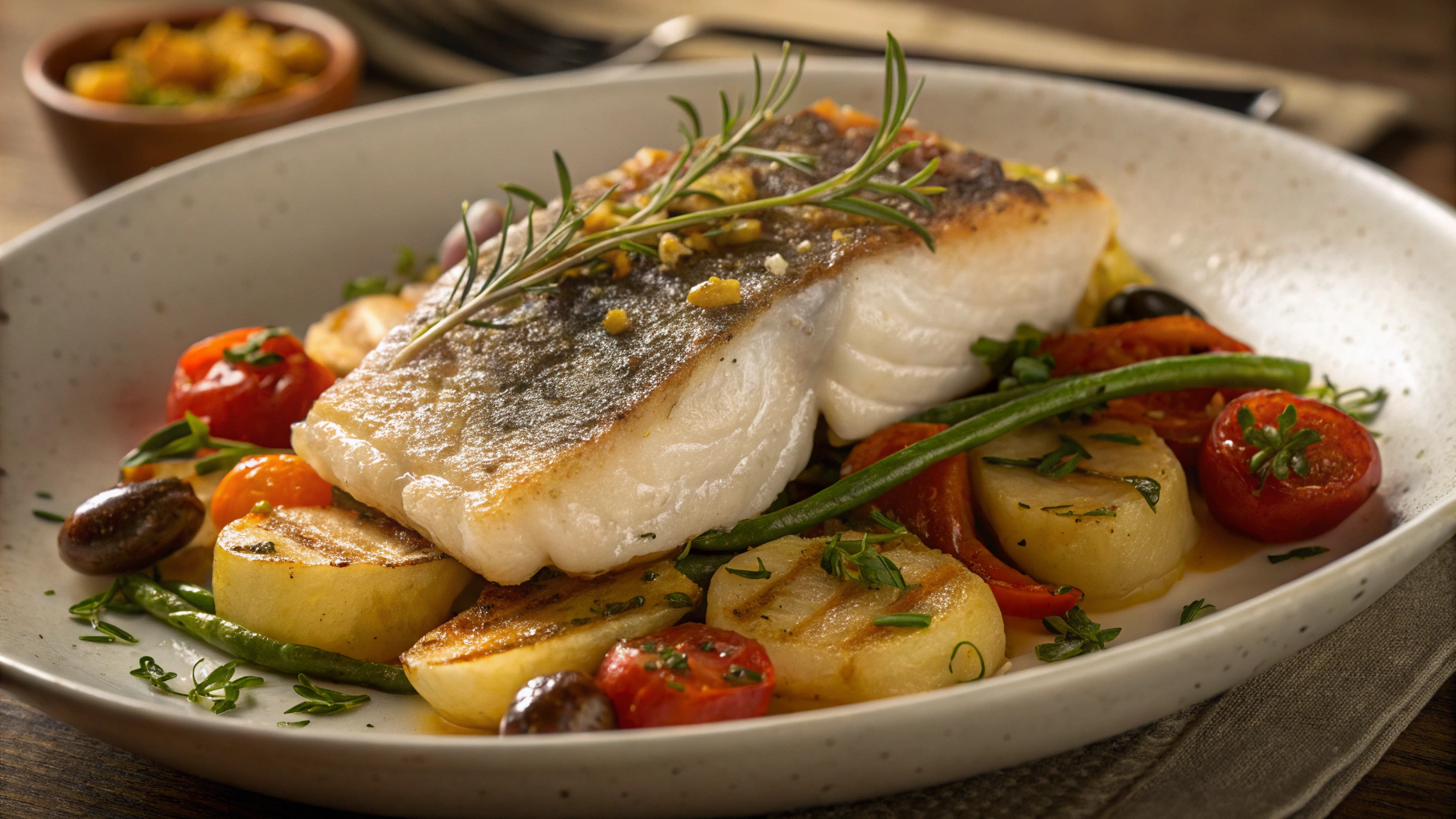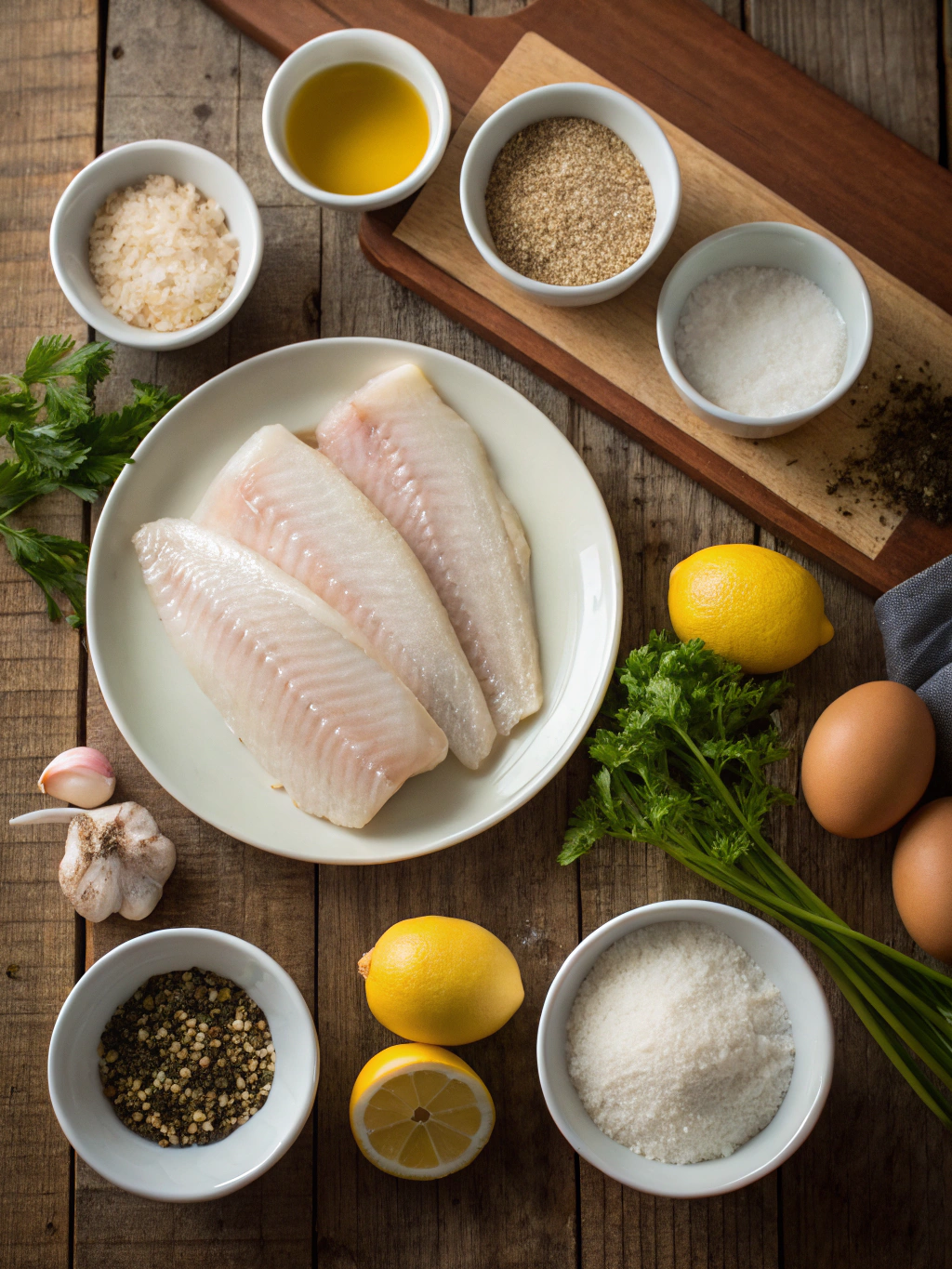Our Finest Rock Fish Recipe: Simple, Exquisite, and Flawless Every Time!

Have you ever stood before a lovely rockfish fillet at the fish counter, pondering how to turn it into an unforgettable culinary experience? Maybe past attempts at cooking fish haven’t quite yielded that perfectly tender texture you were hoping for. If so, your search ends here! We’re delighted to present a fantastic rock fish recipe that’s brimming with taste and remarkably straightforward to get right. Let go of any cooking concerns and embrace a wonderful seafood creation that’s sure to impress. With our assistance, you’ll soon prepare rockfish like a pro.
Understanding Rockfish and Why We Cherish It
Before we get started with the actual cooking, let’s spend a moment on our featured ingredient. ‘Rockfish’ is a broad name given to a number of fish species, commonly inhabiting the waters of the Pacific coast. These are generally lean, white-fleshed fish, possessing a firm consistency and a delightful, subtly sweet taste. Such characteristics make them exceptionally adaptable and an ideal base for a wide array of seasonings and culinary techniques. We are particularly fond of rockfish because it offers:
- Pleasantly Mild: Its delicate flavour profile is never overwhelming, which makes it an excellent choice for individuals new to fish or those who favour a less pronounced “fishy” taste.
- Beautifully Flaky: Prepared properly, rockfish presents a soft, flaky consistency that is truly delectable. This quality is essential for a successful rockfish recipe.
- Swift to Prepare: Similar to many other white fish varieties, rockfish cooks in a relatively short time, rendering it a superb option for weekday evening meals when time is precious.
- Wholesome: It serves as a splendid source of lean protein, beneficial omega-3 fatty acids, and vital vitamins, all of which support a nutritious and well-rounded diet.
Its versatile nature ensures that whether one chooses to pan-fry, bake, or grill, rockfish performs splendidly, transforming the task of cooking rockfish into a truly enjoyable experience.
Selecting Prime Rockfish for Your Culinary Creation
The triumph of any seafood meal hinges on choosing top-notch components. When you are on the hunt for rockfish to use in our recipe, we recommend keeping an eye out for the following:
- Freshness is Paramount: When purchasing fresh fillets, they ought to appear damp and solid, exhibiting a clear, almost opalescent quality. Steer clear of any portions that seem lacklustre, desiccated, or emit a potent fishy smell. Truly fresh fish will carry a subtle scent of the ocean, or hardly any aroma at all.
- Skin-On or Skin-Removed? For pan-frying, our preference often leans towards skin-on fillets, as the skin can achieve a delightful crispness and contributes extra taste. Nonetheless, skin-removed fillets are also perfectly suitable.
- Inspect the Eyes (for whole fish): If you are purchasing an entire rockfish, seek out eyes that are clear, luminous, and slightly convex. Hazy or recessed eyes are a sign that the fish is less than fresh.
- Resilient Flesh: Lightly prod the fish (if pre-packaged, do so through the wrapping). The flesh ought to rebound. If your touch leaves a depression, the fish is no longer at its best.
- Consult Your Fishmonger: Feel free to enquire about the fish’s arrival date or ask for their expert advice. A knowledgeable fishmonger is an invaluable asset.
- Ethical Sourcing: We consistently advocate for selecting seafood from sustainable fisheries. Look for official accreditations or make enquiries about the fish’s provenance. For more information on how to choose sustainable seafood options, please refer to the details provided. Resources such as the Marine Stewardship Council (MSC) are very helpful.
Our Preferred Rock Fish Recipe: Flawless Pan-Fried Fish with a Zesty Lemon Butter Dressing
Although numerous techniques exist for cooking this adaptable fish, our most trusted approach is pan-frying. The reason? It yields exceptionally crisp skin (should you choose skin-on fillets) and wonderfully succulent, flaky meat within. What’s more, it’s swift! We will also guide you in creating a straightforward yet refined lemon butter sauce that perfectly enhances the subtle taste of the rockfish. This technique genuinely showcases the ideal manner of preparing rockfish to achieve optimal taste and consistency.
What You’ll Need for Your Superb Rockfish Recipe
Here is a list of the items required to serve around two to four individuals (this may vary based on fillet dimensions and hunger levels!):
- Two to four rockfish fillets (approximately 150-200g per fillet), with or without skin
- Use one to two tablespoons of olive oil or another high-temperature cooking oil, such as avocado oil.
- One tablespoon of unsalted butter
- Salt, adjusted to your preference
- Freshly milled black pepper, adjusted to your preference
- Optional: A dash of paprika or garlic powder to impart additional taste to the fish
For the Easy Lemon Butter Sauce:
- Two tablespoons of unsalted butter
- One garlic clove, finely chopped (optional, though highly recommended!)
- The juice from half a lemon (roughly one to two tablespoons)
- One tablespoon of freshly chopped parsley (or alternative fresh herbs such as dill or chives)
- Salt and pepper, to your liking

Essential Kitchen Equipment
- A high-standard non-stick frying pan or a thoroughly seasoned cast-iron pan (of sufficient size to accommodate the fillets comfortably without them being too close together)
- A fish slice or a broad spatula
- Kitchen roll
- A small pan (for preparing the sauce, if you choose to make it)
- Measuring spoons and cups
A Phased Approach: How to Cook Rockfish Flawlessly
Right then, let us commence with the cooking! Adhere to these straightforward instructions for an impeccable rockfish meal.
1. Getting the Rockfish Ready
- Thoroughly Dry: Take the rockfish fillets out of their wrapping. With kitchen roll, carefully pat all surfaces until completely dry. This is an absolutely vital stage! A moisture-free surface aids in achieving a wonderful sear and stops the fish from merely steaming in the pan.
- Season Abundantly: Season both sides of each fillet with salt and freshly ground black pepper. Should you opt for paprika or garlic powder, add it at this point as well. Be liberal with your seasoning; it truly elevates the taste.
- Allow to Rest (Optional, yet Advised): If time permits, allow the seasoned fillets to rest at ambient temperature for approximately 10 to 15 minutes prior to cooking. Doing so promotes more uniform cooking.
2. The Cooking Process for Rockfish
- Preheat the Pan: Set your selected frying pan over a medium-high heat. Introduce the olive oil (and the tablespoon of butter, if you’re including it with the oil for searing – this imparts flavour and aids browning). Allow the pan to become thoroughly heated. It’s at the right temperature when the oil gleams or a bead of water sputters and vanishes immediately.
- Introduce Fish to Pan: Gently lay the rockfish fillets into the heated pan. For skin-on fillets, position them skin-side down initially. Avoid cramming the pan; it’s better to cook in separate lots if needed. Too many fillets at once will reduce the pan’s heat, resulting in steaming instead of a good sear.
- Sear Without Moving: Allow the fish to cook without interference for roughly 3 to 5 minutes on the initial side (for skin-on pieces, this is when the skin crisps up). The exact cooking time will depend on the thickness of your fillets. Aim for an attractive golden-brown colour. Try not to shift them excessively.
- Turn Over with Care: Employing a fish slice, cautiously turn the fillets over. Continue to cook for a further 2 to 4 minutes on the reverse side, or until the fish is no longer translucent and separates easily with a fork. The core temperature ought to be 63°C (145°F).
- Take Out and Let Settle: Upon cooking, carefully transfer the fish from the pan to a fresh plate. You may cover it loosely with aluminium foil to maintain warmth whilst you prepare the sauce (if you are making one).
3. Crafting the Easy Lemon Butter Sauce (If Desired)
This sauce provides a vibrant, tangy flourish and is remarkably simple to prepare!
- Liquefy Butter: Using the same pan (feel free to wipe away any excessive charred remnants, though the fish essences contribute taste!) or a compact saucepan, liquefy the two tablespoons of butter over a medium-low heat.
- Incorporate Garlic (if including): After the butter has fully melted, introduce the finely chopped garlic and cook for approximately 30 seconds to one minute, or until it becomes aromatic. Take care to prevent scorching.
- Mix in Lemon Juice: Take the pan off the heat and blend in the fresh lemon juice.
- Introduce Herbs and Adjust Seasoning: Stir in the freshly chopped parsley (or your preferred herb). Season with a touch of salt and pepper according to your palate.
- Present: Generously spoon the warm lemon butter sauce over the cooked rockfish fillets immediately prior to plating up.
Pointers for Perfecting Your Rockfish Recipe
Are you aiming for flawlessly cooked rockfish on every occasion? Bear these helpful hints in mind:
- Avoid Overcooking: This is the cardinal principle for all fish cookery. Rockfish prepares rapidly, and if overdone, it turns out dry and leathery. It is ready when it is uniformly opaque and separates with ease when prodded with a fork. Should you possess a food thermometer, strive for a core temperature of 63°C (145°F).
- Hot Pan, Warm Oil: Ensure your pan is adequately preheated *prior* to introducing the fish. This facilitates the development of that sought-after sear and helps avoid adhesion.
- Allow Ample Room: As previously noted, refrain from congesting the pan. Preparing in separate lots may require a little more time, but the superior consistency achieved makes it worthwhile.
- Handle with Finesse: Rockfish is quite a tender fish, particularly after cooking. Utilise a broad, pliable spatula (a fish slice is perfect) to manage and turn it delicately, thereby preventing it from fragmenting.
- Fresh Herbs Enhance Greatly: Although dried herbs may suffice when necessary, fresh varieties such as parsley, dill, or chives significantly uplift the taste of both the fish and the lemon butter sauce.
- Sample and Modify: Always sample your sauce prior to serving, and tweak the seasoning (salt, pepper, lemon juice) as required.
Mastering how do you cook rockfish effectively often hinges on these seemingly minor yet crucial particulars.
Appetising Serving Ideas for Your Pan-Fried Rockfish
Our pan-fried rockfish is truly splendid served simply, yet it complements a diverse range of accompaniments wonderfully. We’ve compiled a few of our preferred serving recommendations below:
- Steamed or Roasted Vegetables: Items such as asparagus, French beans, broccoli, or roasted baby potatoes make superb partners.
- Light Rice or Quinoa: A straightforward grain-based side dish is perfect for absorbing the delightful lemon butter sauce.
- A Crisp Green Salad: A refreshing, crunchy salad tossed with a vinaigrette offers a pleasing textural and taste counterpoint.
- Smooth Polenta or Creamed Potatoes: For a heartier, more comforting repast, these velvety sides are an ideal match.
- Good Crusty Bread: Perfect for soaking up every last bit of that tasty sauce!
And what about pudding? Following such a wonderful main dish, perhaps you’re inclined towards something sweet and satisfying. Although it’s a slight change of pace, if you find yourself in a baking mood, our much-loved Banana Bread consistently wins approval, or for a speedier alternative, give our 4-Ingredient Banana Bread a go.
Alternative Approaches to Our Classic Rock Fish Recipe
Whilst we are extremely fond of our pan-fried method, rockfish’s adaptability means it can be enjoyed in various other ways. Here are a couple of alternative preparations for you to explore:
Oven-Baked Rockfish
Baking offers an alternative straightforward and wholesome method for preparing rockfish.
- Set your oven to preheat at 200°C (400°F, Gas Mark 6).
- Arrange the seasoned rockfish fillets within a baking dish that has been lightly greased.
- Consider garnishing them with slices of lemon, a light shower of olive oil, and some fresh herbs.
- Bake for a duration of 10 to 15 minutes, contingent on their thickness, until the fish is thoroughly cooked and separates readily. This presents an excellent alternative if you are seeking a way how to cook rockfish with very little bother.
Barbecued or Grilled Rockfish
Grilling or barbecuing lends a delightful smoky character to the fish.
- Warm up your grill or barbecue to a medium-high temperature. Ensure the cooking grates are spotless and generously oiled to stop any sticking.
- Season the rockfish fillets and apply a light coating of oil to them.
- Grill or barbecue for 4 to 6 minutes on each side, or until completely cooked. For more fragile fillets, employing a fish basket can be advantageous.
Do not hesitate to try out various seasonings such as Cajun spice blends, Italian herb mixes, or perhaps a subtle soy and ginger marinade when attempting these alternative methods.
Video Guide: Simple Pan-Fried Rockfish Demonstration
Occasionally, a visual demonstration is most effective! Below is an instructive video showcasing a comparable pan-frying method for rockfish, which could prove quite beneficial for novices wishing to see the technique in action:
Common Queries Regarding Cooking Rockfish
- Q1: What is the flavour profile of rockfish?
- A: Rockfish presents a delicate, somewhat sweet taste coupled with a firm yet flaky consistency. It lacks an overpowering “fishy” quality, which renders it a well-liked option, even amongst those who may be slightly wary of seafood.
- Q2: Is it possible to use frozen rockfish in this recipe?
- A: Certainly! When employing frozen rockfish, it’s crucial to defrost it completely prior to cooking. The optimal method for defrosting fish is to leave it in the refrigerator overnight. After it has thawed, ensure you pat it exceedingly dry with kitchen roll, in the same manner as you would for fresh fish.
- Q3: How can I tell if rockfish is properly cooked?
- A: The most dependable method involves using a food thermometer; it ought to register 63°C (145°F) at its most substantial point. From a visual standpoint, the fish will change from a clear to an opaque appearance and should separate into flakes readily when gently prodded with a fork.
- Q4: Are there suitable alternatives if rockfish is unavailable?
- A: Should you be unable to source rockfish, other delicate, white-fleshed fish with a comparable texture serve as excellent substitutes. Think about using cod, haddock, pollock, tilapia, or snapper as fine alternatives for this specific recipe.
- Q5: Is rockfish a nutritious option?
- A: Indeed, rockfish is considered a wholesome food. It is a fine provider of lean protein, is low in saturated fats, and supplies advantageous omega-3 fatty acids, which play a key role in maintaining cardiac and cognitive health.
- Q6: What causes my fish to adhere to the pan?
- A: This typically occurs due to one or more factors: the pan is not sufficiently hot when the fish is introduced, the fish has not been adequately dried, or an attempt is made to turn it prematurely before a proper crust has developed. Utilising a quality non-stick pan or a well-cared-for cast-iron skillet also proves beneficial.
Prepared to Savour Your Exquisite Home-Cooked Rockfish?
We are quite convinced that this straightforward yet sophisticated rockfish creation will soon be a much-loved dish in your home. Thanks to its subtle taste, pleasing consistency, and swift preparation time, pan-fried rockfish is ideally suited for a weekday evening meal or a more notable weekend culinary event. The vibrant lemon butter sauce transforms it into an exceptionally fine dish, demonstrating that high-quality tastes do not invariably necessitate complex procedures.
Therefore, we warmly invite you to visit your nearby fishmonger, select some splendid rockfish fillets, and put this recipe to the test. We feel certain you will be thoroughly pleased with the outcome! Remember to explore the different versions and serving ideas to tailor it to your preferences.
Have you had a go at our rockfish recipe? Perhaps you possess some preferred hints or alternative methods for cooking rockfish? We would be thrilled to learn from your experiences! Kindly share your thoughts and pictures in the comments section further down, or mention us on your social media platforms. Cheerful cooking to you!






